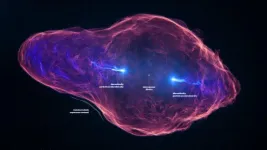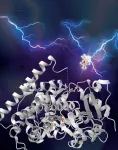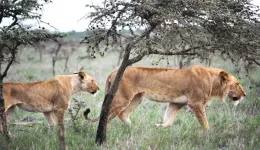(Press-News.org) AMHERST – University of Massachusetts Amherst researchers have received an award to develop a new type of sweat monitor that can be applied to the skin just like a temporary tattoo and assess the molecules present, such as cortisol. The tattoos will ultimately give individuals better insight into their health and serve as a tool for researchers to discover new early indications of diseases.
“There are a lot of vital biomolecules that are present in sweat that we need to measure to really understand overall human performance and correlation to different diseases,” says research lead and assistant professor of biomedical engineering, Dmitry Kireev.
For this initial research stage, Kireev will focus on measuring cortisol, a biomarker associated with stress, stroke, Cushing's syndrome and the rare chronic condition Addison’s disease. However, he hopes to expand the technology to other compounds, such as glucose, lactate, female hormone estrogen, inflammation markers and many more once the method has been established.
Kireev will use the two-year, nearly $200,000 EArly-concept Grant for Exploratory Research (EAGER) grant from the National Science Foundation to develop these graphene-based tattoos. “It’s almost entirely transparent, exceptionally conductive and it really goes into this perfect contact with the human skin,” he says. “It’s imperceptibly self-adhesive—we don’t apply any adhesive, we literally transfer it on skin.”
Most existing methods for analyzing sweat are time-consuming and labor-intensive, limiting them to a laboratory setting. Kireev’s design is based on a method that is simple enough for lay people to use, not just trained clinicians. “Current sweat analysis that’s typically done is in clinics is using liquid chromatography mass spectroscopy,” he explains. “These are all refrigerator-sized machines that are amazing—they could measure all your sweat—but you need to swab the sweat sample, store and analyze. The process is slow, and cost-ineffective.”
However, a device simple for an individual to use would open the possibilities for future research. “We want to have routine analysis [of these bio analytes] so we don’t only get information about people when they’re sick or when they have the problem, but before it happens,” Kireev says.
He also notes that many people are interested in personally tracking their own health and this technology provides growth in the field of personalized healthcare. For instance, cortisol impacts a person’s circadian rhythm. If a person can track their cortisol over the day, it may shed light on their sleep habits.
This research is the merger of two research tracks. First, is the development of this graphene-based tattoo to function as a passive electrode, measuring electrical activity on the body. Second, is research on graphene-based biosensors that are rigid. “Now, the idea is to combine these two technologies together, functionalizing biomolecules on the graphene surface, and employing human skin and sweat as the intermediary,” Kireev says.
Photo and video assets are available for publication here, courtesy of Kireev.
Contact
Dmitry Kireev, dkireev@umass.edu
Julia Westbrook, jwestbrook@umass.edu 413-545-0149
END
Sweat-analyzing temporary tattoo research funded in NSF grant to UMass Amherst researcher
Consumer-facing technology would allow for at-home monitoring of biomarkers linked to disease
2024-01-25
ELSE PRESS RELEASES FROM THIS DATE:
Simulations show how HIV sneaks into the nucleus of the cell
2024-01-25
Because viruses have to hijack someone else’s cell to replicate, they’ve gotten very good at it—inventing all sorts of tricks.
A new study from two University of Chicago scientists has revealed how HIV squirms its way into the nucleus as it invades a cell.
According to their models, the HIV capsid, which is cone-shaped, points its smaller end into the pores of the nucleus and then ratchets itself in. Once the pore is open enough, the capsid is elastic enough to squeeze through. Importantly, the scientists ...
White House rule dramatically deregulated wetlands, streams and drinking water
2024-01-25
The 1972 Clean Water Act protects the "waters of the United States" but does not precisely define which streams and wetlands this phrase covers, leaving it to presidential administrations, regulators, and courts to decide. As a result, the exact coverage of Clean Water Act rules is difficult to estimate.
New research led by a team at the University of California, Berkeley, used machine learning to more accurately predict which waterways are protected by the Act. The analysis found that a 2020 Trump administration rule removed Clean Water Act ...
How an ant invasion led to lions eating fewer zebra in a Kenyan ecosystem
2024-01-25
The invasion of non-native species can sometimes lead to large and unexpected ecosystem shifts, as Douglas Kamaru and colleagues demonstrate in a unique, careful study that traces the links between big-headed ants, acacia trees, elephants, lions, zebras, and buffalo at a Kenyan conservancy. The invasive big-headed ant species disrupted a mutualism between native ants and the region’s thorny acacia trees, in which the native ants protected the trees from grazers in exchange for a place to live. Through a combination of observations, experimental plots, and animal tracking at Ol Pejeta Conservancy, Kamaru et al. followed the ecosystem chain reaction prompted by this disruption. ...
Total organic carbon concentrations measured over Canadian oil sands reveal huge underestimate of emissions
2024-01-25
New measurements of total gaseous organic carbon concentrations in the air over the Athabasca oil sands in Canada suggest that traditional methods of estimating this pollution can severely underestimate emissions, according to an analysis by Megan He and colleagues. Using aircraft-based measurements, He et al. conclude that the total gaseous organic carbon emissions from oil sands operations exceed industry-reported values by 1900% to over 6300% across the studied facilities. “Measured facility-wide emissions represented approximately 1% of extracted petroleum, resulting in total organic ...
Machine learning model identifies waters protected under different interpretations of the U.S. Clean Water Act
2024-01-25
The U.S. Clean Water Act is a critically important part of federal water quality regulation, but the act does not define the exact waters that fall under its jurisdiction. Now, Simon Greenhill and colleagues have developed a machine learning model that helps to clarify which waters are protected from pollution under the United States’ Clean Water Act, and how recent rule changes affect protection. The model demonstrates that the waters protected under the act differ substantially depending on whether the act’s regulations follow a 2006 U.S. Supreme Court ruling or a 2020 White House rule. Under the 2006 Rapanos Supreme Court ruling, the model suggests that the Clean ...
Gamma ray observations of a microquasar demonstrate electron shock acceleration
2024-01-25
Observations of gamma rays, emitted by relativistic jets in a microquasar system, demonstrate the acceleration of electrons by a shock front, reports a new study. The microquasar SS 433 is a binary system made up of a compact object, probably a black hole, and a supergiant star. The black hole pulls material off the star and ejects plasma jets, which move at close to the speed of light. The High Energy Stereoscopic System (H.E.S.S.) is an array of five telescopes in Namibia that observe gamma rays. The H.E.S.S. ...
Astrophysical jet caught in a “speed trap”
2024-01-25
The science fiction author Arthur C. Clarke selected his own seven wonders of the world in a BBC television series in 1997. The only astronomical object he included was SS 433. It had attracted attention already in the late 1970s due to its X-ray emission and was later discovered to be at the center of a gas nebula that is dubbed the manatee nebula due to its unique shape resembling these aquatic mammals.
SS 433 is a binary star system in which a black hole, with a mass approximately ten times that of the Sun, and a star, with a similar mass but occupying a much larger volume, orbit each other with ...
Experts call for major shift in international decision-making to tackle ‘devastating’ impact of urban expansion and avoid ‘planetary catastrophe’
2024-01-25
Leading scientists are today calling for an urgent step change in global governance to save the future of worldwide cities and the planet at large.
Cities are growing at an unprecedented rate, putting overwhelming pressures on exploited land, scarce resources, and fragile ecosystems. The bold proposals, led by experts from the Universities of Bristol, Oxford and Yale, are set out in a Science journal article, proposing a new global advisory system to address the alarming impacts of urban expansion. This system would fulfil a similar function as the Intergovernmental ...
Teaching nature to break man-made chemical bonds
2024-01-25
For the first time, scientists have engineered an enzyme that can break stubborn man-made bonds between silicon and carbon that exist in widely used chemicals known as siloxanes, or silicones. The discovery is a first step toward rendering the chemicals, which can linger in the environment, biodegradable.
"Nature is an amazing chemist, and her repertoire now includes breaking bonds in siloxanes previously thought to evade attack by living organisms," says Frances Arnold, the Linus Pauling Professor of Chemical Engineering, Bioengineering and Biochemistry at Caltech and winner of the 2018 Nobel ...
Tiny ant species disrupts lion’s hunting behavior
2024-01-25
What makes the little old ant think he can disrupt the life of an African lion?
Researchers say it’s more than just high hopes.
In a study published today in the journal Science, a team of scientists reports that a tiny and seemingly innocuous invasive ant species is changing tree cover in an East African wildlife area, making it harder for lions, the world’s most iconic predator, to hunt its preferred prey, zebra.
“These tiny invaders are cryptically pulling on the ties that bind an African ecosystem together, determining who is eaten and ...
LAST 30 PRESS RELEASES:
B cells transiently unlock their plasticity, risking lymphoma development
Advanced AI dodel predicts spoken language outcomes in deaf children after cochlear implants
Multimodal imaging-based cerebral blood flow prediction model development in simulated microgravity
Accelerated streaming subgraph matching framework is faster, more robust, and scalable
Gestational diabetes rose every year in the US since 2016
OHSU researchers find breast cancer drug boosts leukemia treatment
Fear and medical misinformation regarding risk of progression or recurrence among patients with breast cancer
Glucagonlike peptide-1 receptor agonists and asthma risk in adolescents with obesity
Reviving dormant immunity: Millimeter waves reprogram the immunosuppressive microenvironment to potentiate immunotherapy without obvious side effects
Safety decision-making for autonomous vehicles integrating passenger physiological states by fNIRS
Fires could emit more air pollution than previously estimated
A new way to map how cells choose their fate
Numbers in our sights affect how we perceive space
SIMJ announces global collaborative book project in commemoration of its 75th anniversary
Air pollution exposure and birth weight
Obstructive sleep apnea risk and mental health conditions among older adults
How talking slows eye movements behind the wheel
The Ceramic Society of Japan’s Oxoate Ceramics Research Association launches new international book project
Heart-brain connection: international study reveals the role of the vagus nerve in keeping the heart young
Researchers identify Rb1 as a predictive biomarker for a new therapeutic strategy in some breast cancers
Survey reveals ethical gaps slowing AI adoption in pediatric surgery
Stimulant ADHD medications work differently than thought
AI overestimates how smart people are, according to HSE economists
HSE researchers create genome-wide map of quadruplexes
Scientists boost cell "powerhouses" to burn more calories
Automatic label checking: The missing step in making reliable medical AI
Low daily alcohol intake linked to 50% heightened mouth cancer risk in India
American Meteorological Society announces Rick Spinrad as 2026 President-Elect
Biomass-based carbon capture spotlighted in newly released global climate webinar recording
Illuminating invisible nano pollutants: advanced bioimaging tracks the full journey of emerging nanoscale contaminants in living systems
[Press-News.org] Sweat-analyzing temporary tattoo research funded in NSF grant to UMass Amherst researcherConsumer-facing technology would allow for at-home monitoring of biomarkers linked to disease



